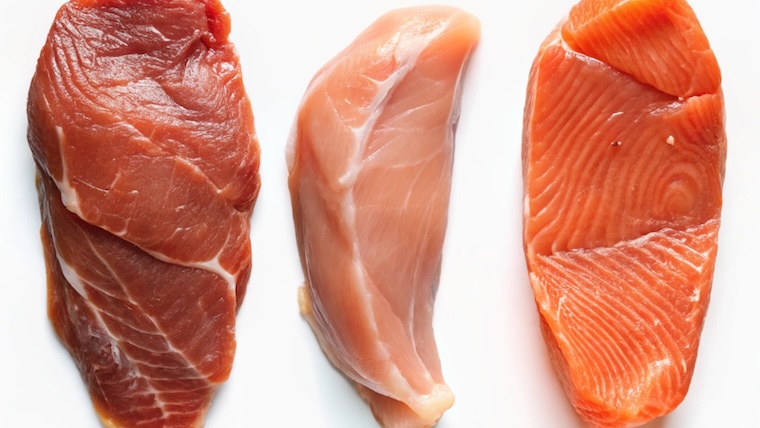Protein is an essential macronutrient for muscle growth. (1) It helps repair and create new cells to build muscle. But how much protein is necessary to optimize muscle growth? Does increased protein intake lead to greater gains, or can excessive protein consumption have undesirable side effects?
Dr. Tom Trommelen, a researcher specializing in protein metabolism at Maastricht University in the Netherlands, and PhD of sports science Dr. Milo Wolf from Stronger By Science addressed these questions on Oct. 13, 2024. Learn what happens to the consumption of excess protein below:
[Related: Best Pre-Workout Supplements]
The Concept of Protein Synthesis
Dr. Wolf explains that protein digestion takes place in four steps:
- The digestion process begins with the teeth. They perform mechanical digestion, which is breaking down food into smaller particles, increasing the surface area for enzymes to act upon.
- Food moves through the digestive tract into the stomach, where gastric glands secrete hydrochloric acid (HCl) to break protein bonds into smaller peptide fragments.
- Food enters the small intestine, where the walls absorb amino acids and release them into the bloodstream.
- These amino acids travel throughout the body via the blood, providing various tissues with the necessary components for protein synthesis or to be oxidized for energy.
Various tissues throughout the body, not just muscles, can utilize amino acids for protein synthesis.
Your muscle has a pretty low protein turnover rate compared to other tissues, like hair.
—Dr. Milo Wolf
Dr. Wolf describes how protein can be oxidized or burned for energy through deamination, which occurs in the liver and involves the removal of the amino group. This process produces keto acids, which the body then uses to convert proteins into glucose, ultimately utilizing this end product for energy.
Protein Ingestion
Dr. Trommelen references previous studies, including one indicating that the initial 20 grams of protein elicits a linear anabolic response, followed by an additional benefit from the next 20 grams, totaling 40 grams. Further protein intake diminishes returns, as excess protein is either burned off or oxidized. However, recent research involving participants consuming 25 grams and 100 grams of protein challenges this notion.

[Related: Best Whey Protein Powders]
According to Dr. Wolf, the study’s findings reveal that consuming between 25 grams and 100 grams of protein doesn’t significantly increase protein oxidation. (2) The levels of amino acids transported from the bloodstream to tissues were notably higher when participants ingested 100 grams than 25 grams. But what happens to the surplus protein?
- 0-4 hours: The 100-gram group exhibited a 20% increase in protein synthesis compared to the 25-gram group.
- 4-12 hours: The 100-gram group showed a 40% increase in protein synthesis over the 25-gram group.
- The release of amino acids into the bloodstream for those consuming 100 grams didn’t cease after 12 hours, whereas for those who ingested 25 grams, the release stopped around the four-hour mark.
These findings suggest that individuals consuming 100 grams of protein in one sitting aren’t wasting protein. (3)
Dr. Trommelen noted that previous studies involved participants consuming a single meal while measuring the anabolic response over four to five hours. However, when individuals consume a substantial amount of protein, they require additional time to digest it effectively.
[Related: Best Creatine Supplements]
Protein Intake Recommendations
Dr. Trommelen recommends that athletes aim for four meals daily, encompassing breakfast, lunch, dinner, and an additional meal before bed. Breaking up meals throughout the day rather than digesting too much in a single meal aids protein distribution.
Dr. Wolf further emphasizes this method can more effectively ensure adequate total protein intake for the body.
More Nutrition Content
- The 5 Best Protein Shake Recipes for Weight Gain, From a PhD in Nutrition
- These Are the Best Pre-Workout Breakfast Foods to Eat, Say Dietitians
- Should You Have a Protein Shake Before Bed? Here’s What RDs and Sports Dietitians Say
References
- Carbone, J. W., & Pasiakos, S. M. (2019). Dietary Protein and Muscle Mass: Translating Science to Application and Health Benefit. Nutrients, 11(5), 1136. https://doi.org/10.3390/nu11051136
- Schoenfeld, B. J., & Aragon, A. A. (2018). How much protein can the body use in a single meal for muscle-building? Implications for daily protein distribution. Journal of the International Society of Sports Nutrition, 15, 10. https://doi.org/10.1186/s12970-018-0215-1
- Trommelen, J., van Lieshout, G. A. A., Nyakayiru, J., Holwerda, A. M., Smeets, J. S. J., Hendriks, F. K., van Kranenburg, J. M. X., Zorenc, A. H., Senden, J. M., Goessens, J. P. B., Gijsen, A. P., & van Loon, L. J. C. (2023). The anabolic response to protein ingestion during recovery from exercise has no upper limit in magnitude and duration in vivo in humans. Cell reports. Medicine, 4(12), 101324. https://doi.org/10.1016/j.xcrm.2023.101324
Featured image: Maria Alam Sraboni / Shutterstock